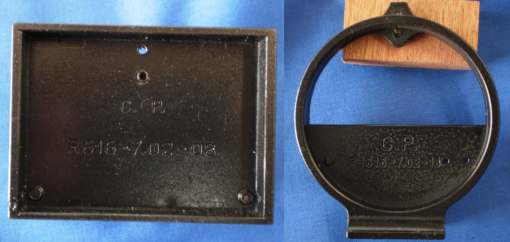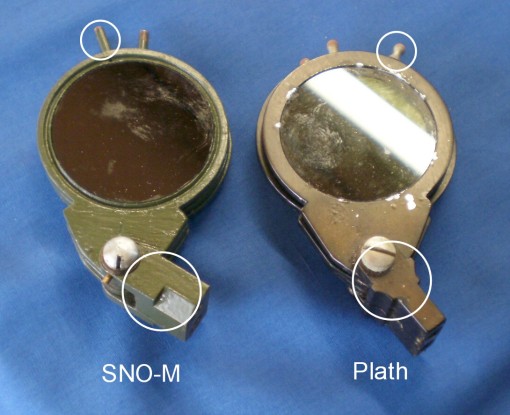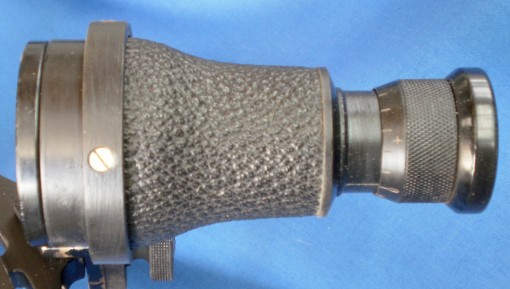In my post for October 2008, I wrote about the USSR SNO-M sextant and gave my opinion that it was identical to the alumium alloy-framed C Plath sextant of WW II. This was based on examination of photographs of putative WW II Plath sextants sold on e-bay, complete with Nazi insignias and Kriegsmarine index numbers. Serial numbers placed them in 1942 and 1943 and their frames were identical to the much later SNO-M frames, with the same pattern of sprues and risers from the casting process visible on the back of the frames (Figure 1). I strongly suspect that these so-called C Plath sextants are forgeries based on changing the obviously different SNO-M index arm and engraving C Plath logos and numbers on to the ends of the limb, which are conveniently vacant for them.
Now it could be argued that the differences are because the backs of the frames were not finish machined because of pressures of war time production. This will not do, as there are other, more subtle differences, indicated in Figures 1 and 2, which show that even allowing for the traces of the casting process, different dies were used. The dies used for pressure casting are very expensive to make but when casting aluminium could be expected to last for up to 100,000 units. During WW II, C Plath made about 11,000 nautical sextants, so it is not very likely that duplicate dies were made or that the original die set wore out. Furthermore, I have been able to examine an indisputably C Plath sextant, whose serial number falls between those of the two probable fakes, differing by only 289 from one of them. Its frame is not the same. (April 2013) Since writing this in July, 2010, I have had the opportunity of examining an indisputably genuine Kriegsmarine sextant from late 1944. The rear of the frame had not been fully machined but other features of the frame casting were as for earlier, genuine, sextants. The official history of C Plath writes of labour shortages at this time.
But it is not just in the frame that there are differences. Cast into the interior of the mirror brackets are part numbers preceded by the initials “C. P.” (Figure 3), while no such numbers will be found inside SNO-M brackets; and the foot of the horizon mirror bracket is displaced upwards in the SNO-M Figure 4). Again, it will not do to argue that extra sets of dies existed, and even if they did, it is difficult to think of a reason why the horizon bracket might have been modified in the middle of a war that was slowly being lost.
The index shades seem to be identical, except that the little brass knobs have a traditional shape in the Plath and are stark cylinders in the SNO-M. Again the horizon shades seem identical, but their mounting s are not. I have circled two points of difference in Figure 5
The index arm of the C Plath sextant was made in two parts, joined by four screws just above the lower index arm expansion, while that of the SNO-M, which carries the serial number, is a one piece alumium stamping with an integral stiffening rib. Obviously, this must be replaced in a forgery and insignia applied(Figure 5), but there is a more subtle difference. To make the arm in two pieces requires that the upper part must be displaced downwards by the thickness of the metal. Careful examination of the upper end of the index arm will show that in the SNO-M (and the probable fakes) is sandwiched between the index mirror bracket and the disc to which the bearing shaft is attached. In the Plath instrument it is the disc that is sandwiched between the bracket and the index arm (Figure 6).
The limb and the rack of the Plath sextant are both of the same radius, while in the SNO-M, the edge of the limb has been machined away and its radius is about 1 mm less (Figure 7). This is also true of the re-incarnated “Plaths” which also all seem, like the SNO-M, to be quintants reading to 140 degrees . The genuine drum is divided to half minutes, unlike the SNO-M, which is divided only to single minutes.
The handle is less easy to fake. The genuine wartime Plath has the Plath logo and name moulded into it (Figure 8), whereas the SNO-M has a brass-lined hole by which it is retained in its case by means of a spring latch. Telescopes too are difficult to replicate (though Tamaya may have done so during WW II) and I have found no evidence to suggest that Plath varied the form of the standard star telescope (Figure 9) until after WW II.
Figure 10 shows that the famous C Plath stick man logo has feet that are too big, has bursitis in the right elbow and shows detail of the index mirror that is not visible in the genuine contemporary logo. The genuine instrument also has the letters “D. S.” stamped next to the logo, showing that it had been examined at Deutches Seewarte, the German Naval Observatory in Hamburg.
Finally, many of the features of the genuine article (as opposed to a re-worked SNO-M, may be seen in Figure 12, which is from the front cover of Die Woche (The Week) from April 1943.














You must be logged in to post a comment.